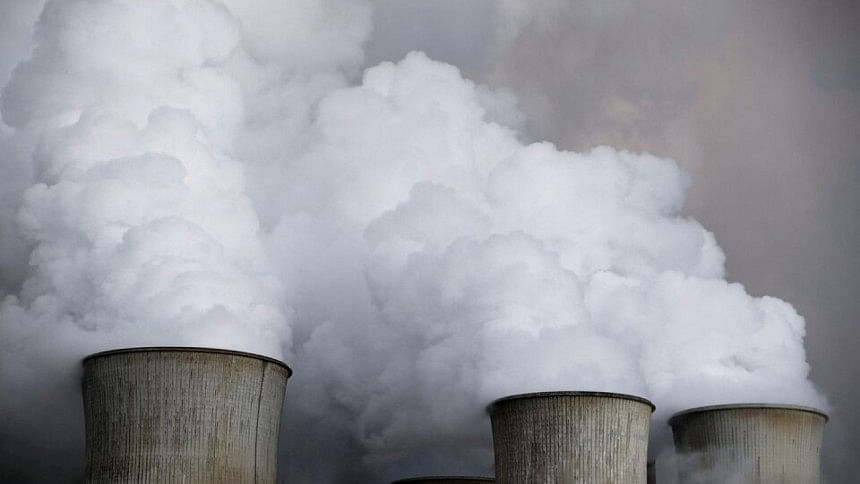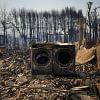An accurate forecast of global warming made 112 years ago

An August 14, 1912 article in the New Zealand newspaper The Rodney & Otamaeta Times contained a story about how burning coal might cause global warming by adding carbon dioxide to the atmosphere. The story reads, "The furnaces of the world are now burning about 2,000,000,000 tons of coal a year. When this is burned, uniting with oxygen, it adds about 7,000,000,000 tons of carbon dioxide to the atmosphere yearly. This tends to make the air a more effective blanket for the Earth and to raise its temperature. The effect may be considerable in a few centuries."
The effect of carbon dioxide, the major greenhouse gas (GHG), is no longer "considerable." It is out of control; it has thrown us into a feedback loop from which there is no exit. So we won't have to wait a "few centuries" for the Earth to become a furnace. Indeed, the prediction made more than 112 years ago essentially validates the seemingly bleak future that we are staring at with trepidation.
The concentration of carbon dioxide in the atmosphere, which serves as the most dependable measure of the global community's advancement towards a secure future, experienced the most significant annual rise from 421.1 ppm in 2023 to 424.6 ppm in 2024. The record increase in 2024 was fuelled by a variety of factors, including record-high GHG emissions, diminished carbon absorption by natural sinks like tropical forests, and the release of vast quantities of carbon dioxide due to wildfires.
The annual rate of increase over the past 60 years is nearly 100 times more rapid than previous natural increases that happened at the end of the last Ice Age, around 11,000 to 17,000 years ago. The concentration now exceeds 50 percent of the levels recorded before the Industrial Revolution in the 18th century, meaning the amount of carbon dioxide is now 150 percent of its value in 1750. For the first time, the global average concentration of carbon dioxide surpassed 430 ppm in May this year, according to the National Oceanic and Atmospheric Administration. The last time the planet had such high levels of carbon dioxide in the atmosphere was probably more than 30 million years ago, well before humans inhabited the Earth and during an era characterised by a significantly different climate.
The buildup of carbon dioxide and other GHGs—methane, nitrous oxide, and fluorinated gases—in the atmosphere has already elevated global temperatures to perilously high levels. The current global mean is around 15 degrees Celsius, encompassing the range from the coldest poles to the hottest deserts. The most relevant reference for the current warming trend is the more recent Pliocene Epoch, which spanned from 5.3 million to 2.6 million years ago. During the mid-Pliocene, atmospheric carbon dioxide levels were comparable to those of today, resulting in heat retention and an increase in global temperatures, about two to three degrees warmer than today.
In 2024, temperatures exceeded those of 2023, making it the hottest year on record. The ten warmest years on record since 1850 have all occurred in the last ten years. Thus, extreme weather events, elevated sea levels, intensified droughts, out-of-control wildfires, deadly storms, and devastating floods, along with detrimental effects on wildlife and critical natural ecosystems, reached unprecedented levels, highlighting the escalating risks of climate change. Besides, warmer temperatures are allowing invasive species and pests to spread, while putting pressure on animals that need a colder climate. Also, the ocean has absorbed enough carbon dioxide to reduce its pH by 0.1 units, resulting in a 30 percent rise in acidity.
An increasing number of climate scientists now believe that achieving the 1.5-degree-Celcius target by the end of this century, as specified in the 2015 Paris Agreement, is unattainable because of escalating carbon dioxide emissions. To provide a context, the temperature has already increased by at least 1.1 degrees Celsius since 1880.
The World Meteorological Organization predicts that the global mean surface temperature for each year from 2025 to 2029 will range from 1.2 to 1.9 degrees above the pre-industrial average. Researchers at the Irish Climate Analysis and Research Unit expect the probability of passing 1.5 degrees on a sustained basis by the late 2020s or early 2030s to reach 100 percent in the next two to three years.
A recent study published in Earth's Future, a transdisciplinary open-access journal, warns that a major effect of a projected rise of 1.5 degrees in global temperature, even temporarily, will be an irreversible shift in global rainfall patterns, potentially affecting nearly two billion people across equatorial regions. Some areas may become deluged while others, particularly Southeast Asia, Northeast Brazil, and parts of Africa, could see dramatic declines in rainfall. As a consequence, people who live in areas that rely on seasonal rainfall for hydroelectric power, drinking water, and farming will be at systemic danger. Delicate ecosystems that depend on regular seasonal moisture cycles, such as savannas and rainforests, are also at risk from the changes.
Ocean and atmospheric systems respond slowly, even in the event of a drop in global temperatures, opening the door to permanent changes. Agriculture, freshwater resources, and food security are increasingly at risk as rainfall becomes unpredictable and uneven across regions. This is a cascade situation that will impact the global food chain, public health, migration, and the energy supply. These systems are unlikely to recover once they are disturbed.
It is now a truism that global warming begets more warming. Hence, the effects of climate change will worsen with every fraction of a degree of warming. In fact, the rapid progression of climate change is driving our planet towards the edge of becoming uninhabitable. As a result, the challenges presented are varied, formidable, and interrelated, ranging from extreme heat to rising sea levels and increased storm surges along the coastal regions. Yet, instead of confronting the challenges posed by climate change, the majority of national governments, international organisations, private sector entities, and non-profit organisations are choosing to ignore the situation.
So, what does our future look like? If we want to keep our planet inhabitable, the most straightforward approach is to significantly reduce GHG emissions immediately, thereby averting the Earth's transition into a new climatic state that would have catastrophic effects on humanity. Otherwise, we will soon have a true glimpse of our overheated future―a world in which no one would want to live.
Dr Quamrul Haider is professor emeritus at Fordham University in New York, US.
Views expressed in this article are the author's own.
Follow The Daily Star Opinion on Facebook for the latest opinions, commentaries and analyses by experts and professionals. To contribute your article or letter to The Daily Star Opinion, see our guidelines for submission.

 For all latest news, follow The Daily Star's Google News channel.
For all latest news, follow The Daily Star's Google News channel. 










Comments